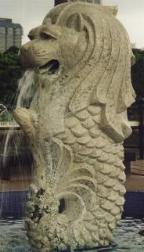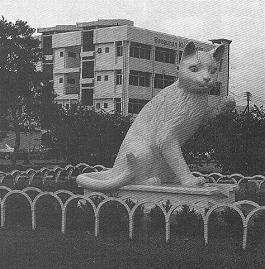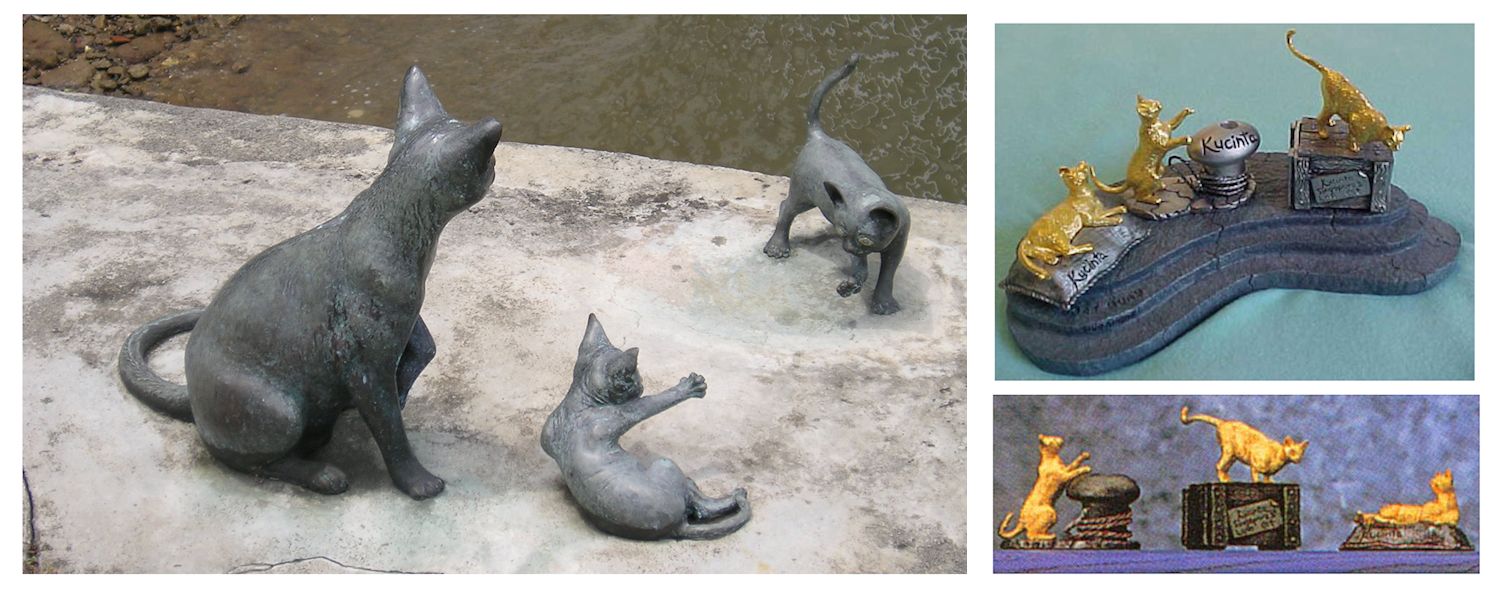
Posters at Singapore's Changi Airport (still there in 1999)
KUCINTA - THE LOVE CAT OF SINGAPORE - AND THE BOBTAILS OF MALAYSIA
(OR "MOGGIES AND MERLIONS")
This article was written after a period spent in Kuantan, Johor Bahru, Kuala Lumpur and Penang in Malaysia and in Singapore City. My ex- husband was living and teaching in Kuantan, giving us a number of local contacts who contributed information. The remainder of this article is based on my own personal observations and subsequent correspondence with cat lovers from Singapore and Malaysia.

Posters at Singapore's Changi Airport (still there in 1999)
FISHTAILED LIONS AND BOBTAILED KITTIES

The island of Singapore was originally known as Temasek ("Sea Town"). It was renamed Singapura ("Lion City") when a visiting Sumatran Prince glimpsed what he thought was a lion (probably a tiger) in 1299. It did not achieve great prominence until the 1800s when Sir Stamford Raffles arrived. Singapore underwent a period of intense economic growth and was declared a freeport. Today it is one of the busiest ports in the world and attracts many tourists, many of whom visit Singapore purely for the shopping.
In the minds of cat enthusiasts, Singapore is associated with the dainty ivory-coloured Singapura cat rather than the majestic tawny lion. However, it is probably easier to find a lion on Singapore than to find a Singapura cat. Like that Sumatran Prince, I glimpsed cats, though they were neither lions nor Singapuras!
The island has a history of feline mascots. Singa, a rather jolly little lion, is mascot of the annual Courtesy Campaign and was introduced in 1979. This event brings Singaporeans together in an ongoing drive to improve everyday courtesies and make Singapore is a welcoming place. For example, a hard-hatted Singa appears on roadworks signs apologising for the inconvenience while a car-driving Singa urges motorists to drive carefully. Singa stickers can be seen in shop windows and he appears in tourist guides.
The internationally recognised mascot of Singapore is the merlion; the lion-headed fish whose statue guards the river mouth at Merlion Park. The merlion (mer- as in mermaid) is also the Singapore Tourist Promotional Board emblem and acts as a seal of approval on reputable stores. "Kucinta, the Love Cat of Singapore", was introduced during 1991 as part of a tourist promotional campaign worldwide. "Kucinta", more familiar to Western cat fanciers as the Singapura cat, is known on the island as the Singapore River Cat, or less attractively as the Drain Cat since cats live in the huge, open monsoon drains during the drier seasons. However, like me, you probably won't see any Singapuras scurrying around or in pet shops.
Despite its popularity in the 1990s, Kucinta is unlikely to succeed the long-established Merlion mascot. When it was introduced, many Singaporeans seemed bemused by the use of the humble cat, rather than the majestic lion, as a promotional emblem. When I visited Singapore in 1994, the Singapura cat seemed to be everywhere except for real life - books, leaflets, sales brochures, badges, porcelain statues, silver and gold statues and tourist teeshirts. I found some particularly attractive silver statues depicting golden cats scurrying over silver crates; sadly these were far beyond my financial means. On tourist goods, Kucinta out-competed Singapore's official merlion mascot. While the breed continues to rise in popularity in the West, in Singapore it is the merlion which now has the last laugh. By the end of 2002, the Kucinta emblem was fast slipping into obscurity as a tourist icon. The Singapore Tourist Board (STB) emphasised that it was never intended to be a mascot in the same way as the merlion. As many as 15 sculptures of Singapura Cats were placed along Singapore River, but many were vandalised and one was even stolen. Three of them still stand at the corner of Cavenagh Bridge.
Kucinta had been popularised by the STB in 1991, following the "discovery" of the Singapura cat by an American breeder. Its "discovery" was challenged and largely discredited in that same year. It was argued that its "discoverer" had created the breed from Abyssinian and Burmese type cats taken to Singapore with her (with documentary evidence to support this). By then the small ivory coloured cat had been accepted as a breed and the charming myth of the Singapore drain cat had circulated worldwide. Rare, expensive and increasing in popularity, Singapura cats are bred in the USA and UK. Over the years, breeders seeking additional breeding cats from Singapore have found very few Singapura-type cats to import and according to the Singapore Cat Club, possibly 1 in 1000 cats (0.1%) resembles this pedigree breed. It is now generally considered that the cat is a man-made breed rather than being a type indigenous to Singapore.
Despite the fact that the Singapura look is rare among native cats, the STB apparently selected Kucinta as an icon representative of cats commonly found at the Singapore River at the time. Cynics suggest that the growing popularity (and hype) of the Singapura breed in America simply made it a convenient icon at the time and Singapurabilia was highly marketable to tourists. No-one can blame Singapore for taking advantage of a breed which claimed, rightly or wrongly, the island as its birthplace. The controversy surrounding the breed in America was simply additional publicity.
As a result of Singapura-fever, Western cat-breeders sought other potential breeds in Singapore. Two further types were imported into the USA, but have vanished into obscurity. The Limau Kohlum was reportedly a red-ticked cat of Singapura type. The Wild Abyssinian was a darker ticked tabby with striped legs, chest and forehead. Though mentioned in magazines and breed books at the time, neither was developed into a breed. Native bobtails were not considered for breed development.
Statues of Kucinta can be found on the banks of the Singapore river at Cavenagh Bridge where the cat supposedly originated. These, however, are the only Singapuras that tourists are likely to see. I saw numerous nervous cats of Oriental or Bobtail type, but found no Singapuras - somewhat disappointing since tourist leaflet claimed that they could be seen near the river! However, it was not surprising considering the breeds rather tenuous link with the island.
|
|
|
|
Typical Singapore street cats - feral, bobtailed and most were tabbies and torties. Not a single ivory colour ticked coat to be seen! |
|
During my stay I saw tabbies, torties, bicolours and self-colours, but not a single cat with "ticked fur the colour of old ivory". At the time I wondered if this meant that Kucinta was a shy and elusive creature, like the lion which gave the island its name. However, having scoured the river area and not managed even a glimpse of Kucinta, I eventually began to wonder "are there any Singapuras in Singapore?". The Singaporeans I have since spoken to regarded the Singapura as an American breed, not a Singaporean cat at all! When I asked "Where can I see a real Singapura cat?" the response was "In America" or an explanation that "real Singapore cats" come in many colours and have short tails.
Although greatly in demand by tourists, the cat fancy style Singapura is less adored by native Singaporeans according to rescue societies, pet shops and vets. The American-developed Singapura is not representative of local cats which are smaller, have the bobbed and knotted tails typical of cats in the Malay peninsula and are most often mackerel tabby or calico. In 2002, a bobtailed Singapura kitten appeared in a pedigree litter, perhaps an echo of Singapore's bobtailed cats. The gene was possibly introduced many generations ago by one of the few native cats which resembled the Singapura breed closely enough to be exported for breeding.
The Singapore Cat Club gets regular calls from Europe and Japan asking to buy and import Singapura cats. It is embarrassing for the club to admit that there are no Singapuras in Singapore and that the Singapore Cat Club is aiming to buy a pair from the US - the Singapura's real "home country" - and has been on the waiting list for two years for cats which cost up to $4000 each (the figure for breeding cats - and shipping from USA to Singapore - according to Singapore Cat Club). Very rarely a native cat will appear which resembles the Singapura.
Singapore's Animal Lovers League, a society which pays for the sterilisation of feral and stray cats, sees little point in importing what they see as a man-made breed. Singapura cats should represent the true local cats of Singapore - multicoloured bobtails. Although undoubtedly charming in shape and colour, the Singapura breed is considered an American creation. The native bobtailed cats are not held in any particular regard either at home or overseas; the creation of a pedigree breed bearing little resemblance to those native cats has not changed this.
Far from being representative of Singapore's native cat population, the Singapura familiar to American and European cat lovers seems to exist only in the form of three statues at Cavenagh Bridge on the Singapore River. These, along with other sculptures in the area, tell the history of the Singapore river. As for the history of the Singapura cat, when I asked a correspondent if the strain had died out in Singapore, she replied "LOL, it was never here in the first place."
A CITY CALLED "CAT" - THE KUCHING CAT MUSEUM

No cat-lover's visit to Malaysia would be complete without a visit to Kuching in East Malaysia. Kuching is located on the River Sarawak in Borneo and is capital of Malaysia's Sarawak state. Quite how it was named Kuching, or "cat", isn't clear, but according to legend the Englishman Sir James Brooke was given the right to rule Sarawak by the grateful Sultan of Brunei in 1841 as a reward for quelling a local rebellion. Being unsure of the town's Malay name, he simply pointed to the riverside and his local guide, thinking he was pointing to a scavenging feral cat (rather than to the town) said "kuching".
Kuching contains a cat museum, originally housed as an exhibition in Sarawak Museum. All sorts of cats are covered from the tiger through to the Singapura (Singapore is, after all, just off the tip of the Malay peninsula!). The displays range from cats made of wood, stone, porcelain, pewter or fabric through to posters, greetings cards and stamps. Manís relationship with cats is traced through history - from Egyptian cat-worship (though most people forget that cat-worship was a local cult, not an Egypt-wide practise) though Middle Ages persecution to the modern exhibits.
The art and literature exhibits include reproductions of Old Masters which depicted cats right through to Louis Wain (1860-1939) and modern artists such as Zoe Stokes. Other areas are devoted to stories and illustrations of famous cat lovers and their cats: Dickens, Churchill and Theodore Roosevelt. One of the most popular exhibits is the one on Cats and Children which range from classic books and toys through to modern cartoons such as Top Cat and Tom & Jerry.
BOBTAILS, COLOURPOINTS AND THE SIX-FINGER CATS OF LAKE CHINI
Singapore is linked to the Malaysian town of Johor Bahru (JB) by a causeway. JB is uninspiring, but is the terminus of the toll motorway to the Malaysian capital, Kuala Lumpur (KL), about five hour's drive away. KL is very cosmopolitan with a great diversity of people. Here I found Siamese-patterned cats and grey Korat-like cats - well Thailand (Siam) is just next-door! The Siamese were closer to the kink-tailed old-style (Applehead) Siamese than to the tubular-bodied, wedged-headed modern Siamese, but not as chunky as Colourpointed British Shorthairs. I was pleased to see them as I prefer the older style. Most of the local moggies had whippy kinked tails or bobtails.
|
KL Petshop |
Colourpoint |
Pet-keeping is more common in KL than in the smaller towns I visited. During a ramble through KL, I discovered the "China Zoological Supplies" pet shop. Think of those news photos of finches crammed into small cages; as well as overcrowded cage-birds there were stacked cages of puppies and kittens (mainly Balinese, Angora and Persian; longhairs being uncommon and therefore more desirable). Although equipped with the basics, the cages were stacked outside the shop three or four high and the kittens were not in the best of health. I was unimpressed and it was hard to decide whether they were better or worse off than the scavenging cats living near restaurants.
A Malay friend of mine tells me that his mother keeps several rescued cats, including longhairs. During the most hot and humid season she bathes the longhaired cats every few days to keep them insect-free and healthy. Longhairs can suffer in the heat and humidity and trimming, clipping or even shaving is sometimes necessary for the cat's own comfort. I hoped that if someone was willing to actually purchase a kitten, it too stood some chance of a decent life. A few of the cats in KL and Penang wore collars, including an Asian Tabby sitting outside the Burmese Temple (where else!) in Penang, but the majority seemed to be strays, neither welcomed nor chased away.
The coastal town of Kuantan, close to the bay of Telok Chempedak, is a 30 minute plane journey from KL. It was in Kuantan that I saw caged cats at a Chinese cafe. They received a great deal of attention from tourists who feared the worst, but all was revealed at closing time when the cafe was locked up and the cats let loose. Due to the amount of discarded food from hawkers' food stalls on the streets there is a problem with rat infestation. During the day the two cats were confined to show-sized cages while at night they patrolled the cafe to deter rats. Luckily (for me) I saw no cats being kept for the table, though I was informed by Chinese contacts in Malaysia that cats are indeed eaten by some.
We spent as much time as possible in the countryside as an antidote to the high-rise scenery of Singapore and the bustle and grime of KL. Malaysia is a fascinating country, from its busy cities to its beautiful rainforests which are sadly being stripped of their hardwoods and replaced by rubber trees or oil palm plantations. In an out-of-the-way kampung (village) near Lake Chini I met a family of bobtailed polydactyl cats. The owners were fond of their 'six-finger cats' and the laid-back cats put up with a great deal of cuddling from the children. These confident village cats were in great contrast to the camera-shy town cats.
|
Lake Chini - polydactyl bobtail and his proud owner. |
Kuantan White Bobtail Male (The photo has been enlarged and digitally re-focussed.) |
In the towns, nervous oriental cats, with tails ranging from tip-kinked to Bobcat-style stumps, scavenged at outdoor restaurants. One very pregnant restaurant cat condescended to sit on my lap and be cuddled - until I ran out of suitable titbits! Torties and tabbies predominated, perhaps such kittens were better camouflaged for survival, though at one restaurant I glimpsed a ghostly white tomcat with a perfect bunny-rabbit tail. He was a very well endowed tomcat, so his 'three-lumped' posterior was an amusing sight. Since he was very shy, we were regularly treated to this sight.
In the Malay tongue, cat is "Kucing" and "Kucinta" roughly means "sweet little cat". A more accurate translation of kucinta is 'kucing' (cat) and 'cinta' (love). There is a town called Kucing, but despite its name there are no more cats there than in comparable towns. At the time of my visit, the world-renowned Selangor Pewter had released a series of nine exquisite pewter cats modelled on popular breeds. Needless to say I bought the full set and had some fun with metal detectors at Kuantan and Kuala Lumpur airports!
|
Malay Tabby Bobtail |
Kucing Malaysia |
Back in 1994, Malaysia had no native cat breed. There had been historical references to tabby bobtail "Malay" cats from the Malaysian peninsula as early as 1881 and I saw similar type cats during my visit. Since my original visit, cat-lovers have developed a breed called the Piawaian Kucing Malaysia (Malaysian Piawaian Cat, often known simply as Kucing Malaysia - Malaysian Cat). This attractive cat resembles a Tonkinese in type and a mitted Ragdoll in colour. According to an American judge in KL, another breed has been in development since 1996; the Malaysiana looks like a small tiger with mackerel striping and an athletic, moderate, Abyssinian-like type. I had hoped to find out more during a return visit in 2000, but had to fly home after only two days in KL due to a broken ankle.
From the majestic merlions of Singapore to the streetwise strays of Malaysian towns, the peninsular is home to a variety of felines - real and mythical and sometimes as elusive as Kucinta.

Kucinta Bronze Statues and Gold-Plated Models
LINKS
Cat Welfare Society of Singapore
You are visitor number